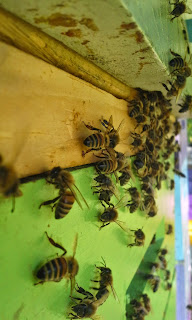I'm seeing a repeat of last summer's problem. The bees just can't keep their queens alive.
In spring they requeen as usual. I do my best to do splits on the stronger hives to prevent swarming and losing precious bees.
Sometimes in spring the requeening fails and they make another. I often give them a frame of eggs (with the nurse bees on the frame) to keep them going if they're running out of brood.

This summer, most of my hives have been constantly requeening all summer long. Here I am in mid Aug and I have at least six of 16 hives that are in the middle of requeening. The other remaining hives have successfully requeened.
Two of the hives have utterly failed. They had queens hatch out, I even saw them in the hive, but then shortly after they no longer had a queen. She either didn't make it back from going out to mate or she somehow failed in the hive. They have no eggs or brood of any kind. These bees are antsy. They run, buzz loudly and are quick to sting. They're upset and with good reason.
They're doomed unless there's an intervention.
Normally since it's so late in the year these hives would be blended with other hives. But I'm a hobby beekeeper and a rescuer so I bought some queens. I've installed two on the worst hives.
One strong but queen and eggless hive I gave a frame of eggs, larvae and bees from their mother hive that they were originally split from a couple years back. DNA seems important because the bees took two eggs and moved them and created two queen cells to put them in.

These cells are now capped and I'm counting the days to the hatching. Now take note that when I gave this hive the frame of eggs from their mother, I transplanted two lovely not yet capped queen cells from another hive. A week later I came back to find they had chewed out the introduced queen cells. It seems this hive wants to use the DNA of their mother hive to create their own queen instead. So I'm going to let this play out to see if they're successful.
At this stage I don't expect to take any more honey from the hive because once they're rolling again they'll need whatever honey they can store for winter.

Another hive has 5 capped queen cells and capped brood. The capped brood tells me that sometime in the last 10 to 24 days there was a queen laying eggs in that hive. She has obviously failed in some way and they are replacing her. I'm watching these cells as well. This has been my best hive that I've had for seven years. I'd prefer to keep this gene going because it's a strong one for really good bees.
Last week while in the bee yard a person was there going for a nature walk. She told me my bees had swarmed and there was a clump of them on the pine tree. I asked her to call me if she ever saw that again and pointed to my phone number posted on a sign in my yard. (Silently saying to myself damn it why didn't you call me!!!!)
The difficult part with giving frames of eggs and bees at this time of year is having to lift off honey boxes to dig down to the nest. I hate doing that as ultimately bees get squished and the boxes are heavy. I don't want to remove honey just yet and there's a reason why.

Last year in the fall when I went to take more honey off I found the bees had almost none. They had been requeening all last summer, their numbers were low and so they were weak and couldn't bring in enough honey for themselves, let alone for me too. I had to give boxes to them from other hives. So this year I'm being very careful about how much honey I take.
It's a difficult balancing act. None of us wants to see a hive fail.
 Imagine how a little bit of knowledge can grow into an idea. Then the idea grows into an incredible ingenious project.
Imagine how a little bit of knowledge can grow into an idea. Then the idea grows into an incredible ingenious project. (http://http://elephantsandbees.com and http://savetheelephants.org/human-elephant-conflict/elephants-bees/ are the web sites).
(http://http://elephantsandbees.com and http://savetheelephants.org/human-elephant-conflict/elephants-bees/ are the web sites). Elephants are naturally afraid of bees. With this little bit of knowledge the idea was born of creating "bee fences" around crops. It keeps the elephants out of the crops.
Elephants are naturally afraid of bees. With this little bit of knowledge the idea was born of creating "bee fences" around crops. It keeps the elephants out of the crops. The farmers harvest the honey and have an increase in family income because of the honey they have for sale.
The farmers harvest the honey and have an increase in family income because of the honey they have for sale.











































